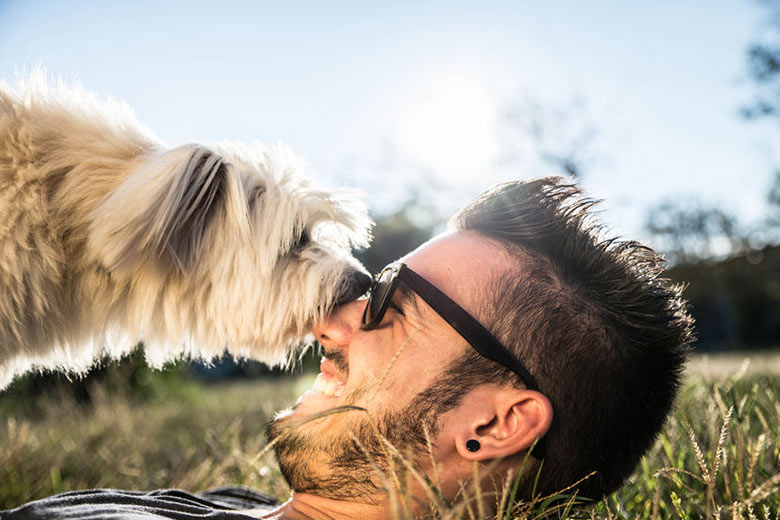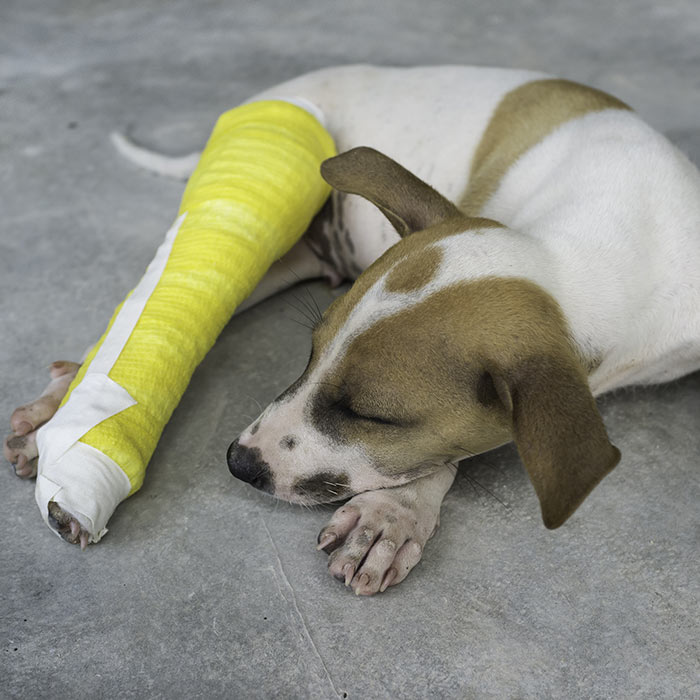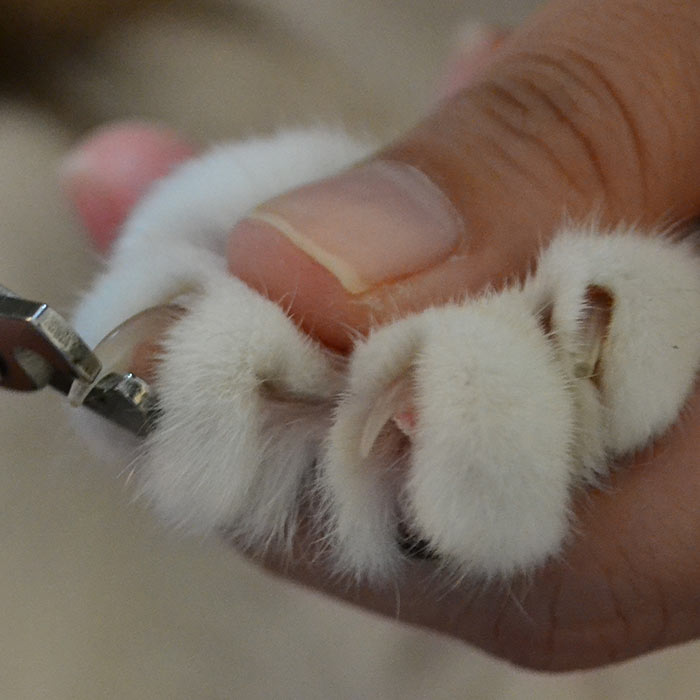Fracture of the skull in dogs and cats
What is fracture of the skull?
The skull is the bony structure that supports the face and forms a protective cavity for the brain. It is comprised of many bones that fuse together during development to form a solid case. The bones of the skull can be divided into two groups:
- The cranium or cranial cavity, which surrounds the brain, and which can be subdivided into:
- The calvarium, or skull cap, the upper part or “roof” of the cranial cavity
- The cranial base, or floor, of the cranial cavity
- The facial bones which are comprised of:
- The bones surrounding the eyes, nasal and oral cavities and sinuses
- The mandible (lower jaw), which is the only movable bone of the skull
Among mammals, skulls differ more in size and shape among domestic dogs than in any other species, while the cat’s skull is unusual in having very large orbits (eye sockets) and a powerful and specialised jaw.

Source: http://i.imgur.com/0eSgsFb.jpg

A fracture is a break in a bone. When abnormal stress is placed upon the skull, a fracture or break can occur. Typically, a skull fracture occurs when an animal suffers some type of head trauma, especially a car accident, a fall from a height or a hit to the head, usually as a result of cruelty and abuse. A skull fracture, if severe, may also cause neurological damage (brain injury).
Intracranial fractures:
Intracranial fractures involve the calvarium (skullcap or roof). Most intracranial fractures are closed fractures; that is, there is a broken bone that does not penetrate the skin. The bone is fractured, but the overlying skin is intact.
There are several types of intracranial skull fractures, including:
- Linear skull fracture – A simple break in the cranial bone that looks like a thin line, with no movement or depression of the bone.
- Depressed skull fracture – A break in the cranial bone with a depression of the bone inwards, towards the brain. Depression fractures result when multiple linear fractures occur in a small area and the fragments depress into the brain. This typically occurs as a result of a direct blow to the head, causing skull indentation and possible underlying brain injury.
- Comminuted skull fracture – the break is in three or more separate pieces of varying shapes or the bone has shattered into many pieces. Comminuted fractures of the calvarium are the most severe; the sharp fragment edges can easily lacerate internal structures such as the meninges (the protective covering of the brain) and the cerebral cortex (outer layer of the brain).
Extracranial skull fractures
Extracranial skull fracturescan also occur in dogs and cats, including:
- Facial fracture – Affecting the bones of the face, most commonly the nasal bones. Usually trauma related.
- Mandibular fracture – Affecting the jaw bone, this is commonly seen in dogs and cats. These often occur when the animal falls from a height and suffers facial trauma, or because of a road traffic accident or fighting. Mandibular fractures can also occur as a result of dental disease (most notably periodontal disease in small breed dogs), metabolic disease and neoplasia.
Symptoms of fracture of skull in dogs and cats
Symptoms depend on the severity of the injury and accompanying injuries to the brain or facial structures. Minor fractures may have few if any symptoms. However, most skull fractures in dogs and cats result from blunt force or penetrating trauma which can produce numerous signs and symptoms. These may be obvious, such as visible injuries and bleeding. There are also more subtle signs of fracture, such as poor balance and confusion, slurred speech and a stiff neck.
The symptoms of a skull fracture are also related to the area of the skull that is affected:
- Fractures of the nose and upper jaw region – difficulties in chewing and eating, broken or missing teeth, inability to open or close the mouth, difficulty breathing through the nose, and facial swelling of the cheek, nose and jaw
- Fractures of the cheek bone – facial swelling and difficulties with the adjacent eye
- Fractures of the base of the skull – clear fluid draining from the ears and nose (cerebrospinal fluid leakage)
- Fractures of the calvarium can cause injury to the underlying brain with resultant neurological signs, for example:
- Ataxia (poor coordination, unsteady gait)
- Head tilt and circling
- Behavioural changes
- Blindness
- Coma, loss of consciousness
- Drowsiness
- Seizures
- Changes in pupil sizes, either dilated (large) or constricted (small) or unequal (one large, one small)
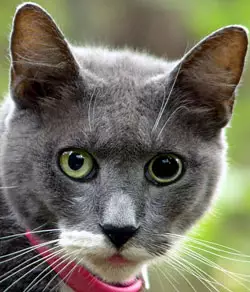
Source: https://vcahospitals.com/-/media/vca/images/lifelearn-images/anisocoria-in-cats-1.ashx?la=en&hash=7B633870616962F7E1016251E58B5971
Causes of fracture of skull in dogs and cats
Most skull fractures occur as a result of significant sudden impact or great force to the head or face, which causes abnormal stress on the bones, such as:
- Being hit by a car
- Falling from a height
- Fights with other animals
- Sporting injuries
- Assault or abuse
A minority of skull fractures are pathologic fractures caused by diseases, such as bone cancer, that weaken the bone, causing them to break more easily. Stress fractures are the result of pressure on the same spot over extended periods of time.
Diet may affect bone health, contributing to fractures where it is inadequate, for example, a lack of calcium or an excess of Vitamin A or phosphorus can weaken the bones. An inherited collagen defect may also cause weakening of the bones.
Age and breed are contributing factors; young bones that are not fully formed are susceptible to certain types of fractures, while older, brittle bones are also at greater risk.
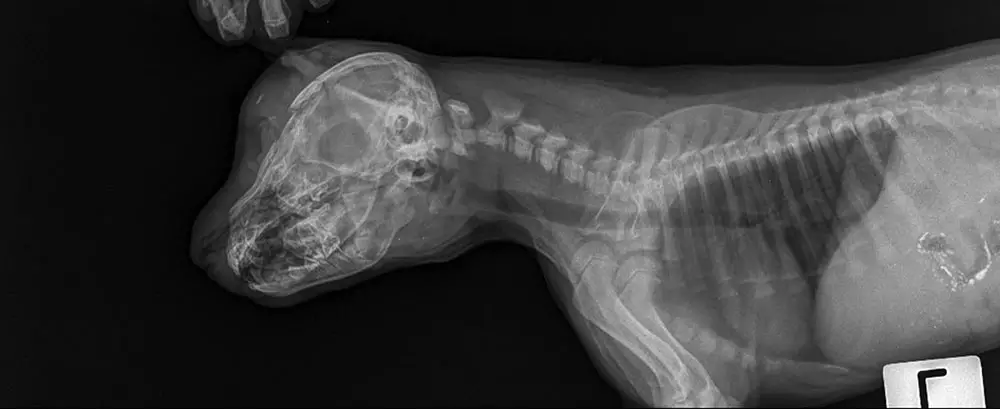
How is fracture of skull in dogs and cats diagnosed?
Because skull fracture can have serious implications it is important to seek immediate medical attention. The veterinarian will perform a physical examination, obtain a thorough medical history and inquire about the circumstances of the injury and any symptoms. A neurological exam, including checking the respiration, pupil size, eye movement and consciousness, can help to determine the extent of brain injury, if any. Pain medication and sedatives may be administered, particularly if the animal is distressed. Imaging will help determine the severity of the fracture and its location, and assist in planning for possible surgery.
Imaging studies:
- X-rays of the skull will be taken to evaluate for skull, jaw and sinus injuries
- X-rays of the chest and abdomen to look for internal injuries caused by the trauma
- MRI or CT scans to check for brain injury, look for haematomas (localised bleeding outside of the blood vessels), and determine the extent of the bone fracture

Source: http://i.dailymail.co.uk/i/pix/2011/08/23/article-2029219-0D8ADB7A00000578-647_634x452.jpg

Source: http://i.dailymail.co.uk/i/pix/2011/08/23/article-2029219-0D8ADB6700000578-917_634x426.jpg
Prognosis
Prognosis for skull fractures can vary greatly depending on which area of the skull is affected and the type of fracture. If there are no life-threatening injuries resulting from the trauma and no neurological impairment, with the correct treatment and diligent aftercare, most fractures will heal well with time.
However, fractures of the calvarium can cause injury to the underlying brain, resulting in neurological impairment. Abnormal brain function can range from minor to more severe. The potential long-term effects of these fractures range from none to lifelong neurological dysfunction and death.
Treatment for fracture of skull in dogs and cats
Treatment depends on the severity of the injury. Emergency care for potentially life-threatening injuries caused by the trauma is paramount. Once the animal is stabilised, additional treatment may include:
- Stabilising and treating neurological disorders
- Surgery to re-align and pin breaks to the upper jaw and cheekbone
- Surgical repair of depressed skull fractures
- Analgesics (pain medications) to relieve discomfort
- Oxygen to assist with breathing
- Steroids to reduce brain swelling
Most fractures of the skull do not need surgical treatment. Removal of the compressed fragments of the skull is generally not performed unless the animal’s neurological symptoms are worsening. No treatment is generally necessary for simple or linear fractures.
Fractures of the nose and upper jaw:
- May not need any treatment
- May be treated with immobilisation of the jaws with wires or a restricting muzzle
- May require surgery to realign teeth and reopen the airways
Fractures of the cheek bone:
- May not need any treatment
- May be surgically stabilised with pins or wires
- May be surgically removed and replaced with small bone plates
Ongoing care and maintenance:
It can take many months for the animal to recover from a skull fracture, and follow-up visits and x-rays will be necessary to monitor progress. Neurological deficits, if present, may take up to several months to repair or may be permanent, and may slow the rate of recovery.
During recuperation, the animal will need to be confined indoors, with restricted activity for several weeks; cage rest may be required. Painkillers will be necessary to manage pain in the early stages. If the jaw is injured, chewing will be difficult and painful; the animal’s weight may require monitoring and soft, nutritional foods will be recommended.
Bones usually take four to six weeks to heal, or up to eight weeks in elderly animals. In most cases a follow-up physical and neurological examination is required six to eight weeks after surgery, with x-rays taken to monitor bone healing. Once an X-ray has shown the skull has healed, normal physical activity can usually be resumed.
In summary
A skull fracture is a crack or break caused by abnormal stress on the calvarium (skullcap) or facial bones, usually from a traumatic event like being hit by a car or falling from a height. Symptoms of a skull fracture depend on the area of the skull affected. Neurological problems can occur if skull fragments penetrate the underlying brain structures, evident by symptoms such as lack of coordination and seizures.
X-rays are usually performed to assess the damage and determine the best course of treatment. Most skull fractures do not require surgical correction; in cases of fractures of the jaw, nose and cheeks, the bones may be stabilised with screws, pins, wires or bone plates. While most animals will fully recover, the recovery period may be many months, especially if neurological impairment has occurred.
Bow Wow Meow Pet Insurance can help protect you and your pet should an unexpected trip to your vet occur.
- Find out more about our dog insurance options
- Find out more about our cat insurance options
- Get an instant online pet insurance quote


More information
- https://en.wikibooks.org/wiki/Anatomy_and_Physiology_of_Animals/The_Skeleton#The_Skull
- https://veteriankey.com/the-skeleton/
- https://en.wikivet.net/Mandibular_Fractures_-_Cat_%26_Dog
- https://www.petplace.com/article/dogs/pet-health/fracture-of-the-skull-in-dogs/
- https://www.cuteness.com/article/recognize-treat-dogs-skull-fracture
- http://cal.vet.upenn.edu/projects/saortho/chapter_17/17mast.htm
- https://www.cat-world.com.au/broken-skull-in-cats.html
- https://teachmeanatomy.info/head/osteology/skull/
- https://www.vetinfo.com/treating-cat-skull-fracture.html
- https://www.petmd.com/cat/conditions/mouth/c_ct_upper_lower_jaw_fracture?page=show


